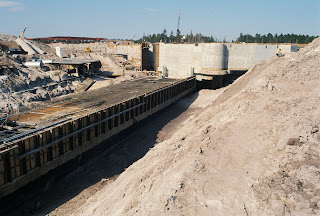We conclude this week's countdown of Walt Disney World anniversary milestones with... a countdown. This time, it's the ticking clock for construction crews and Imagineers putting the finishing touches on the Magic Kingdom park for its grand opening, a date emblazoned on the face of Cinderella Castle for all to see. (All photos ©Disney)
Although an initial groundbreaking ceremony had taken place in 1967, quite a bit of preparation had to be done to the land before actual work could begin. Construction started in earnest on May 27, 1969, with just over two years to go before the big day. The pictures you see here represent the final weeks and months leading up to the opening.
In the photo above, City Hall is nearly complete, and the Victorian woodwork is being added to the front of the Emporium. Below, the towering pylons at the entrance to Tomorrowland await their final paint and tile. Trees have been planted along the waterway, fresh sod is being laid and a wooden mock-up of a Plaza Swan Boat is placed in the canal to test for clearances (although the actual attraction wouldn't be ready to open until May 1973).
In this next shot, we see the famed Liberty Tree. This 100+ year old southern live oak was identified on the south end of Walt Disney World Resort property, and then transplanted to Liberty Square. Steel rods were drilled through the center of the tree, allowing it to be lifted onto the truck by crane, driven slowly to the Magic Kingdom and lowered into place. The holes left by the rods were then sealed, allowing the tree to survive and thrive.
Our last shot today offers a peak into Fantasyland, where Dumbo is almost ready to fly. This is the original 10-arm Dumbo the Flying Elephant attraction, which was replaced by the current 16-arm version in the early-90s. Look closely at the photo, and you can also spot one of the Skyway towers and the palm trees surrounding the lagoon for 20,000 Leagues Under the Sea.
As we prepare to embark upon the celebration of Walt Disney World's 40th year, Dumbo the Flying Elephant is under construction once again... this time as part of Storybook Circus in New Fantasyland. The circus big top is already going vertical, and Dumbo will soon fly east to his new home, set to debut in 2012.




















































